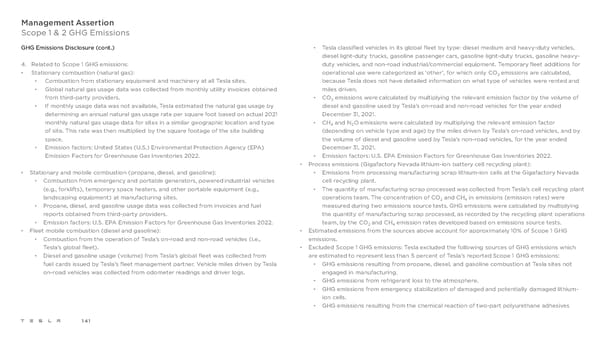Management Assertion Scope 1 & 2 GHG Emissions GHG Emissions Disclosure (cont.) • Tesla classified vehicles in its global fleet by type: diesel medium and heavy-duty vehicles, diesel light-duty trucks, gasoline passenger cars, gasoline light-duty trucks, gasoline heavy- 4. Related to Scope 1 GHG emissions: duty vehicles, and non-road industrial/commercial equipment. Temporary fleet additions for • Stationary combustion (natural gas): operational use were categorized as ‘other’, for which only CO emissions are calculated, 2 • Combustion from stationary equipment and machinery at all Tesla sites. because Tesla does not have detailed information on what type of vehicles were rented and • Global natural gas usage data was collected from monthly utility invoices obtained miles driven. from third-party providers. • CO emissions were calculated by multiplying the relevant emission factor by the volume of 2 • If monthly usage data was not available, Tesla estimated the natural gas usage by diesel and gasoline used by Tesla’s on-road and non-road vehicles for the year ended determining an annual natural gas usage rate per square foot based on actual 2021 December 31, 2021. monthly natural gas usage data for sites in a similar geographic location and type • CH and N O emissions were calculated by multiplying the relevant emission factor 4 2 of site. This rate was then multiplied by the square footage of the site building (depending on vehicle type and age) by the miles driven by Tesla’s on-road vehicles, and by space. the volume of diesel and gasoline used by Tesla’s non-road vehicles, for the year ended • Emission factors: United States (U.S.) Environmental Protection Agency (EPA) December 31, 2021. Emission Factors for Greenhouse Gas Inventories 2022. • Emission factors: U.S. EPA Emission Factors for Greenhouse Gas Inventories 2022. • Process emissions (Gigafactory Nevada lithium-ion battery cell recycling plant): • Stationary and mobile combustion (propane, diesel, and gasoline): • Emissions from processing manufacturing scrap lithium-ion cells at the Gigafactory Nevada • Combustion from emergency and portable generators, powered industrial vehicles cell recycling plant. (e.g., forklifts), temporary space heaters, and other portable equipment (e.g., • The quantity of manufacturing scrap processed was collected from Tesla’s cell recycling plant landscaping equipment) at manufacturing sites. operations team. The concentration of CO2 and CH4 in emissions (emission rates) were • Propane, diesel, and gasoline usage data was collected from invoices and fuel measured during two emissions source tests. GHG emissions were calculated by multiplying reports obtained from third-party providers. the quantity of manufacturing scrap processed, as recorded by the recycling plant operations • Emission factors: U.S. EPA Emission Factors for Greenhouse Gas Inventories 2022. team, by the CO2and CH4emission rates developed based on emissions source tests. • Fleet mobile combustion (diesel and gasoline): • Estimated emissions from the sources above account for approximately 10% of Scope 1 GHG • Combustion from the operation of Tesla’s on-road and non-road vehicles (i.e., emissions. Tesla’s global fleet). • Excluded Scope 1 GHG emissions: Tesla excluded the following sources of GHG emissions which • Diesel and gasoline usage (volume) from Tesla’s global fleet was collected from are estimated to represent less than 5 percent of Tesla’s reported Scope 1 GHG emissions: fuel cards issued by Tesla’s fleet management partner. Vehicle miles driven by Tesla • GHG emissions resulting from propane, diesel, and gasoline combustion at Tesla sites not on-road vehicles was collected from odometer readings and driver logs. engaged in manufacturing. • GHG emissions from refrigerant loss to the atmosphere. • GHG emissions from emergency stabilization of damaged and potentially damaged lithium- ion cells. • GHG emissions resulting from the chemical reaction of two-part polyurethane adhesives 141
 Tesla 2021 Impact Report Page 140 Page 142
Tesla 2021 Impact Report Page 140 Page 142